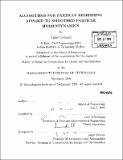| dc.contributor.advisor | John R. Williams. | en_US |
| dc.contributor.author | Galagali, Nikhil | en_US |
| dc.contributor.other | Massachusetts Institute of Technology. Computation for Design and Optimization Program. | en_US |
| dc.date.accessioned | 2010-05-25T20:38:39Z | |
| dc.date.available | 2010-05-25T20:38:39Z | |
| dc.date.copyright | 2009 | en_US |
| dc.date.issued | 2009 | en_US |
| dc.identifier.uri | http://hdl.handle.net/1721.1/55074 | |
| dc.description | Thesis (S.M.)--Massachusetts Institute of Technology, Computation for Design and Optimization Program, 2009. | en_US |
| dc.description | Cataloged from PDF version of thesis. | en_US |
| dc.description | Includes bibliographical references (p. 57-59). | en_US |
| dc.description.abstract | This thesis outlines adaptivity schemes for particle-based methods for the simulation of nearly incompressible fluid flows. As with the remeshing schemes used in mesh and grid-based methods, there is a need to use localized refinement in particle methods to reduce computational costs. Various forms of particle refinement have been proposed for particle-based methods such as Smoothed Particle Hydrodynamics (SPH). However, none of the techniques that exist currently are able to retain the original degree of randomness among particles. Existing methods reinitialize particle positions on a regular grid. Using such a method for region localized refinement can lead to discontinuities at the interfaces between refined and unrefined particle domains. In turn, this can produce inaccurate results or solution divergence. This thesis outlines the development of new localized refinement algorithms that are capable of retaining the initial randomness of the particles, thus eliminating transition zone discontinuities. The algorithms were tested through SPH simulations of Couette Flow and Poiseuille Flow with spatially varying particle spacing. The determined velocity profiles agree well with theoretical results. In addition, the algorithms were also tested on a flow past a cylinder problem, but with a complete domain remeshing. The original and the remeshed particle distributions showed similar velocity profiles. The algorithms can be extended to 3-D flows with few changes, and allow the simulation of multi-scale flows at reduced computational costs. | en_US |
| dc.description.statementofresponsibility | by Nikhil Galagali. | en_US |
| dc.format.extent | 63 p. | en_US |
| dc.language.iso | eng | en_US |
| dc.publisher | Massachusetts Institute of Technology | en_US |
| dc.rights | M.I.T. theses are protected by
copyright. They may be viewed from this source for any purpose, but
reproduction or distribution in any format is prohibited without written
permission. See provided URL for inquiries about permission. | en_US |
| dc.rights.uri | http://dspace.mit.edu/handle/1721.1/7582 | en_US |
| dc.subject | Computation for Design and Optimization Program. | en_US |
| dc.title | Algorithms for particle remeshing applied to smoothed particle hydrodynamics | en_US |
| dc.type | Thesis | en_US |
| dc.description.degree | S.M. | en_US |
| dc.contributor.department | Massachusetts Institute of Technology. Computation for Design and Optimization Program | |
| dc.identifier.oclc | 587063527 | en_US |
